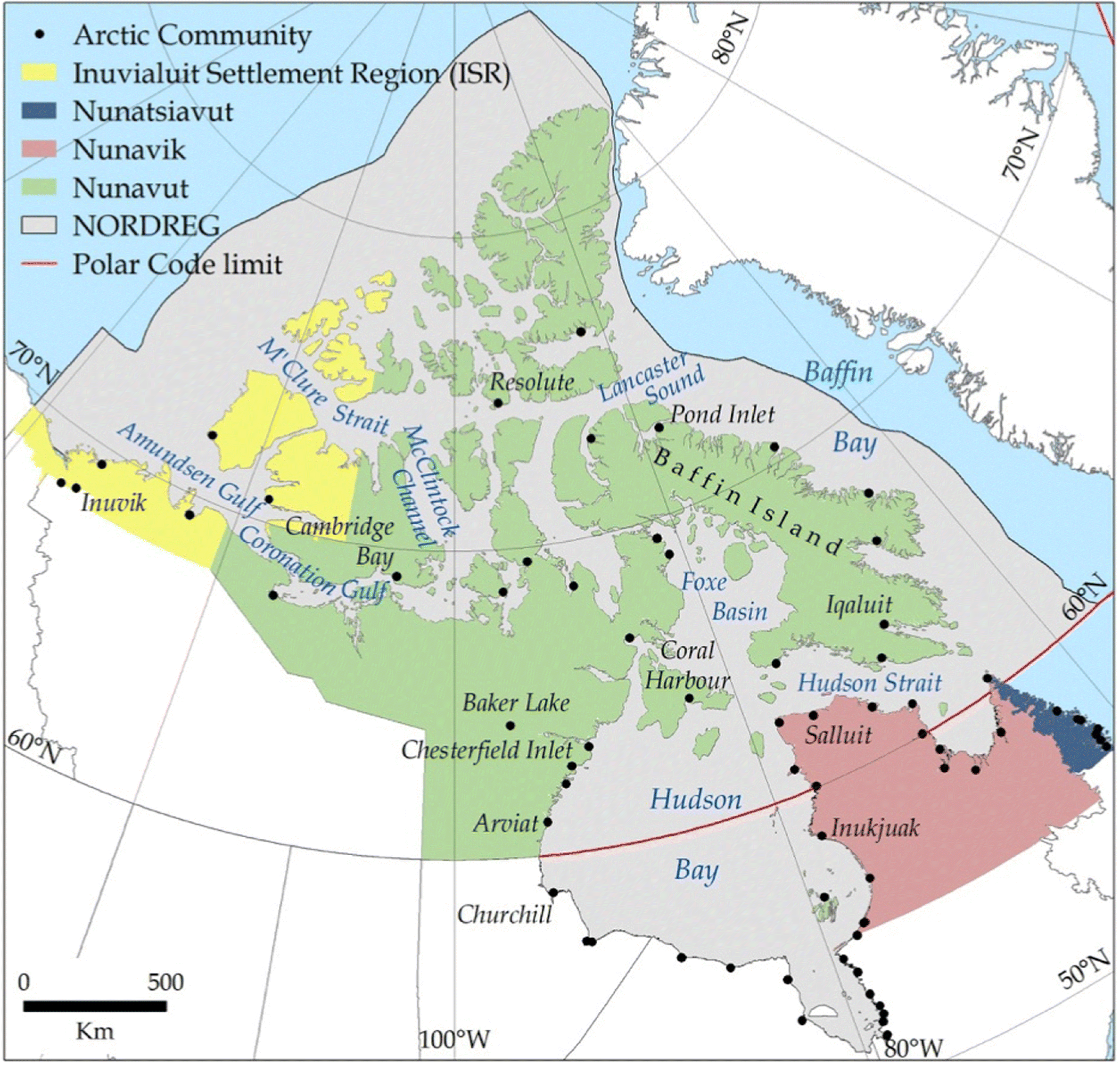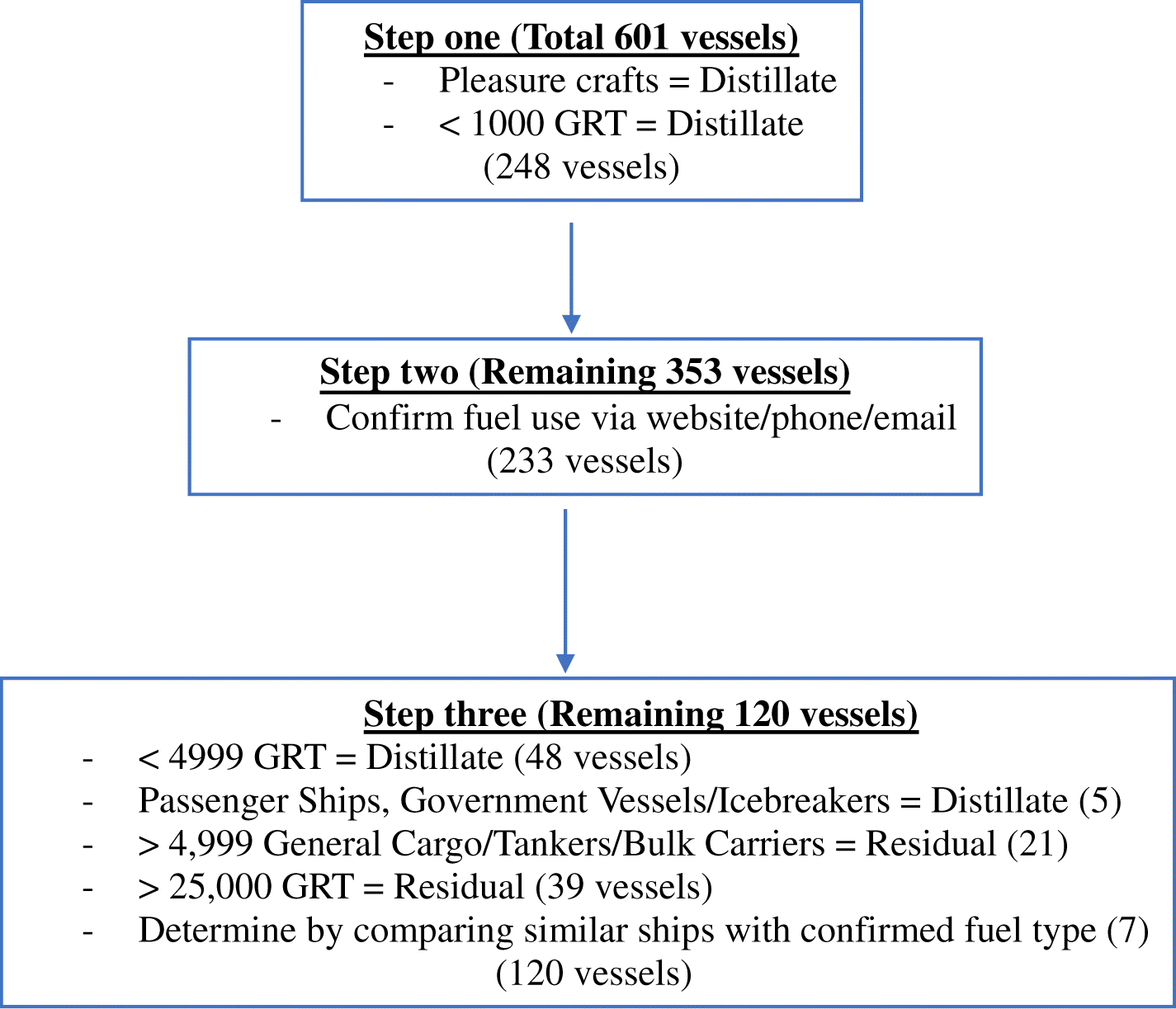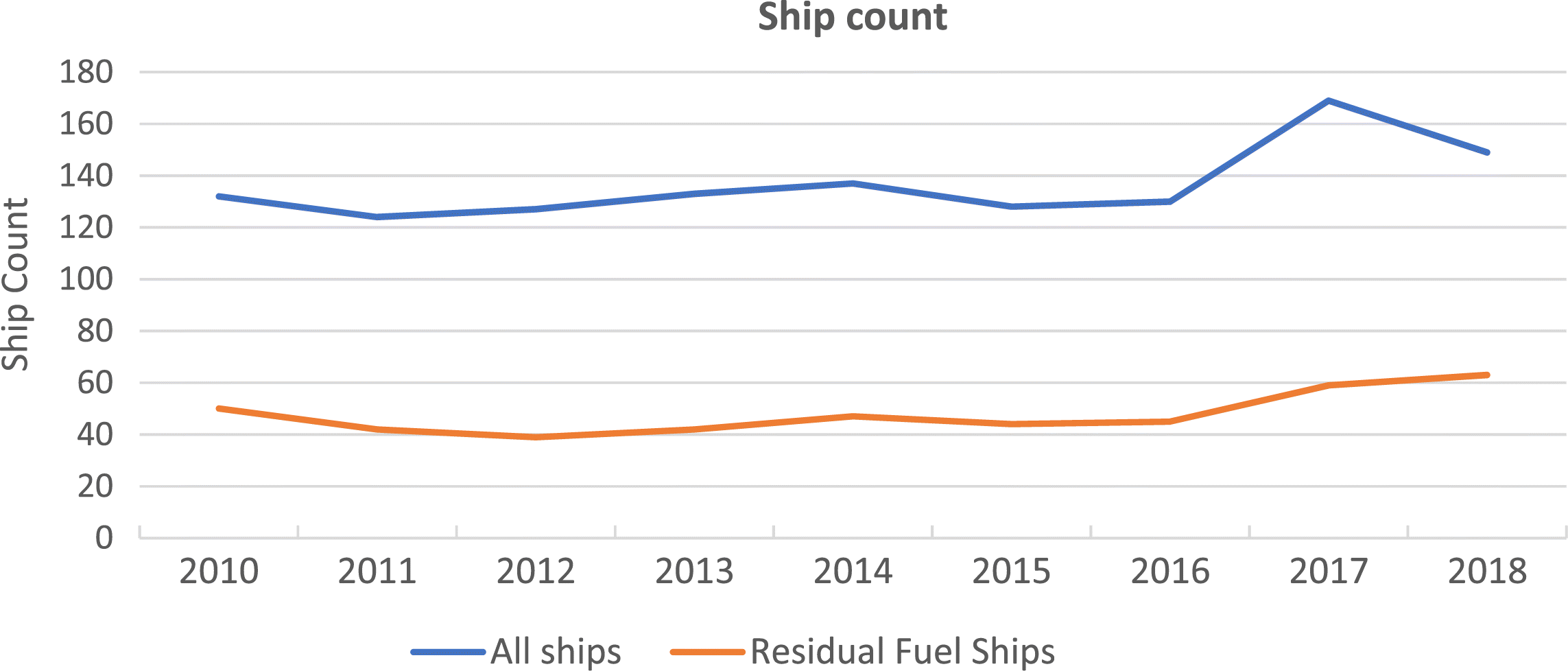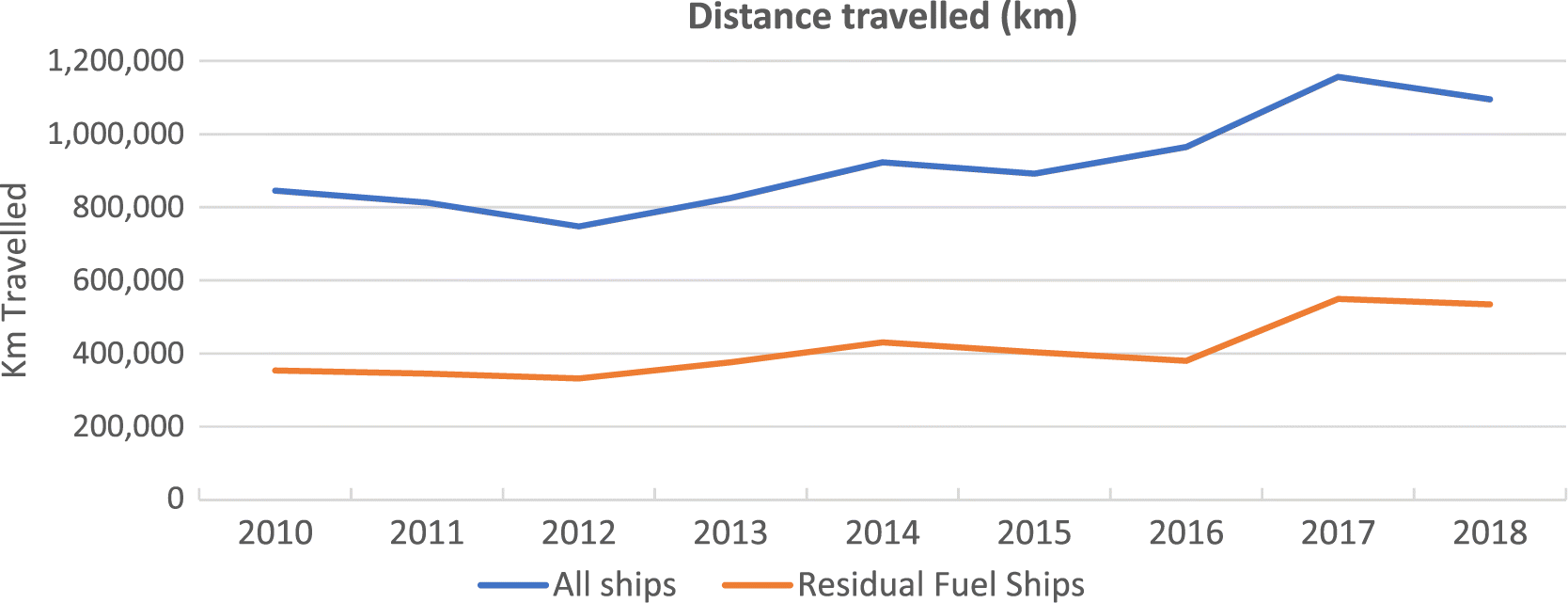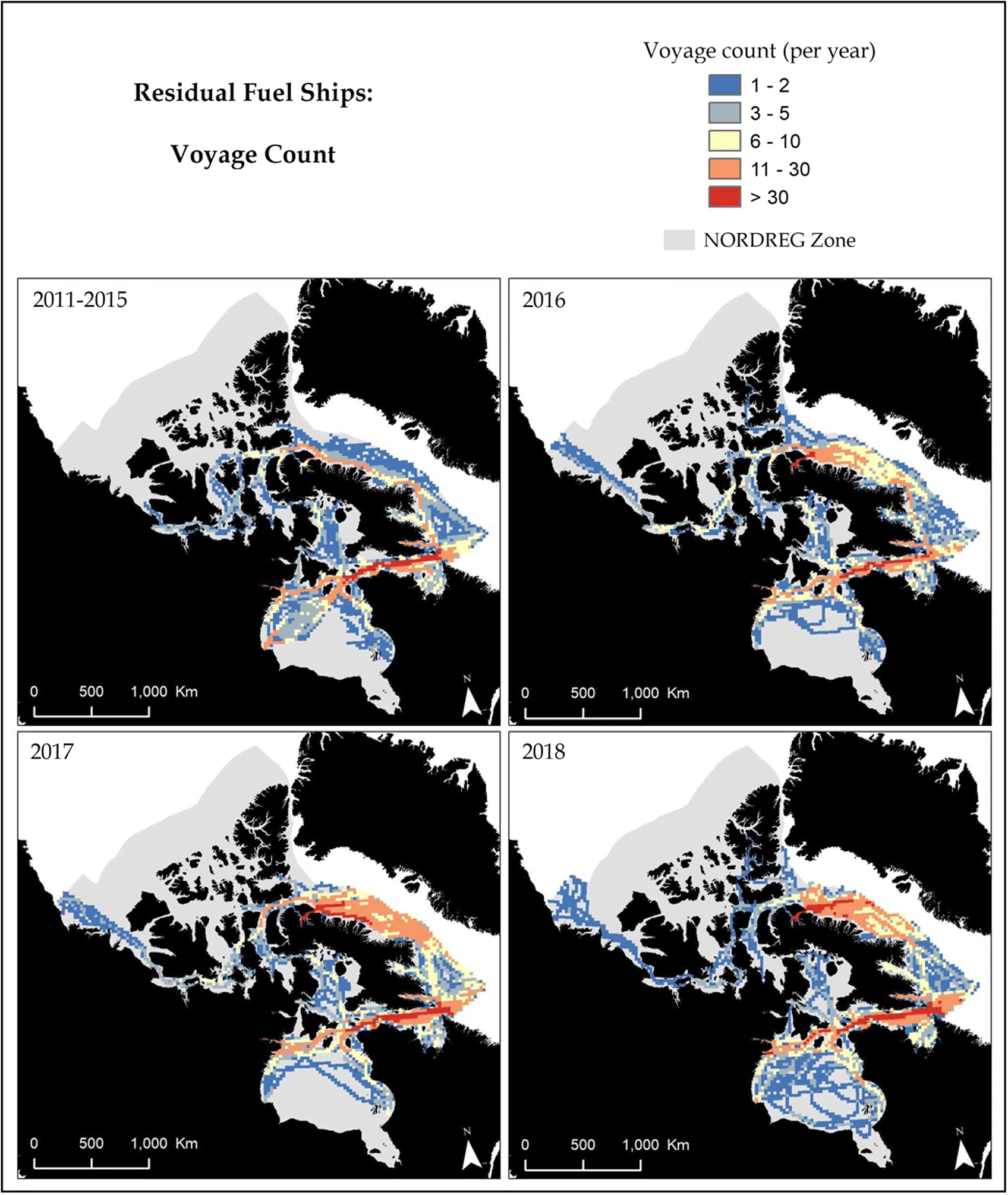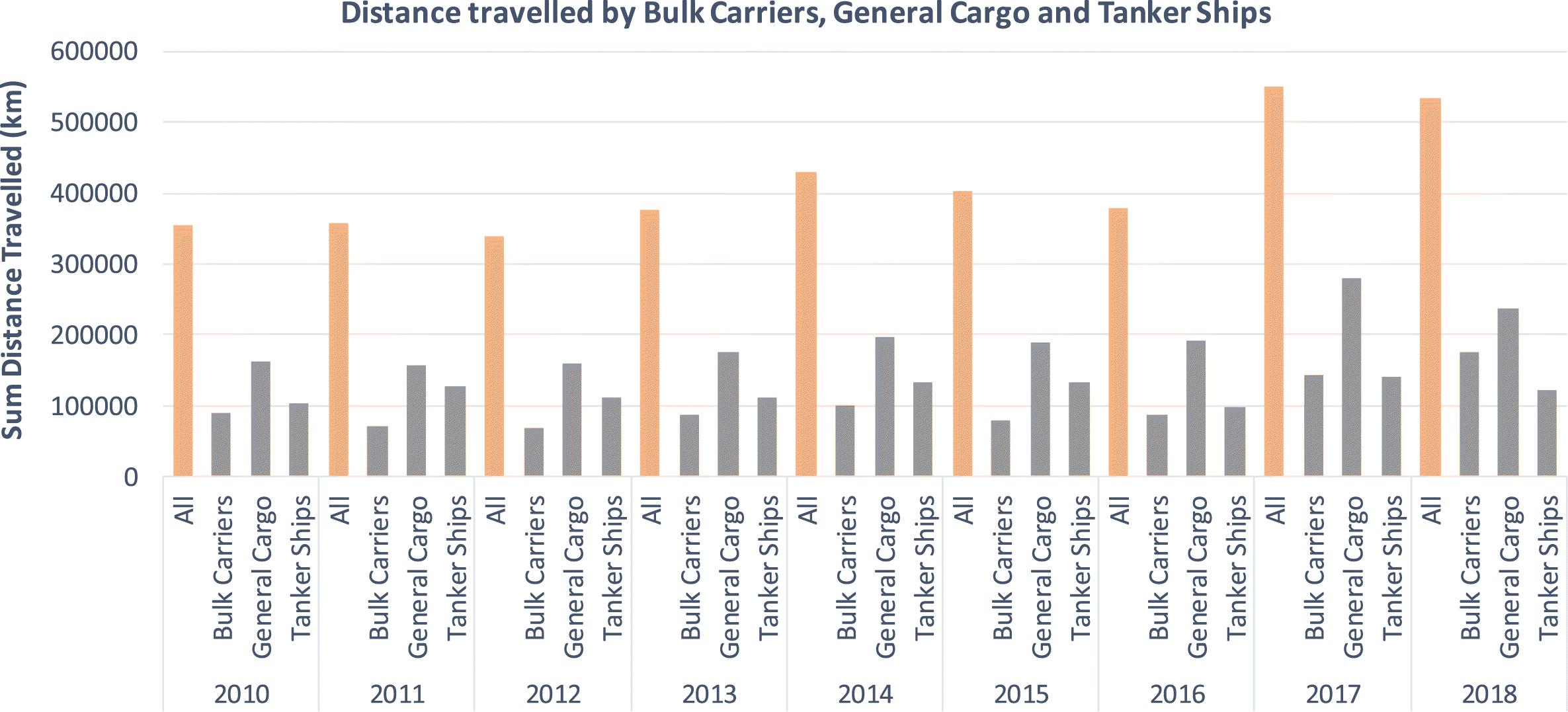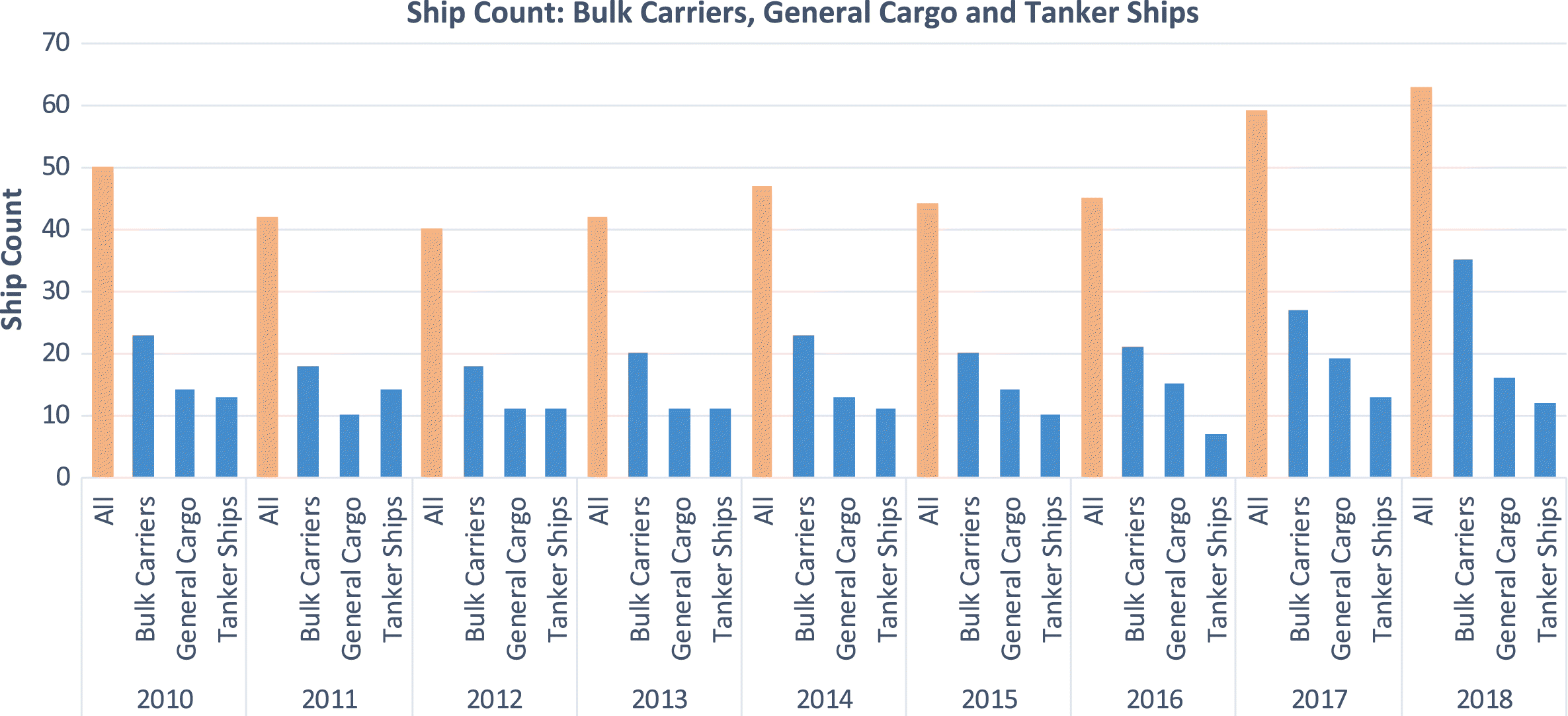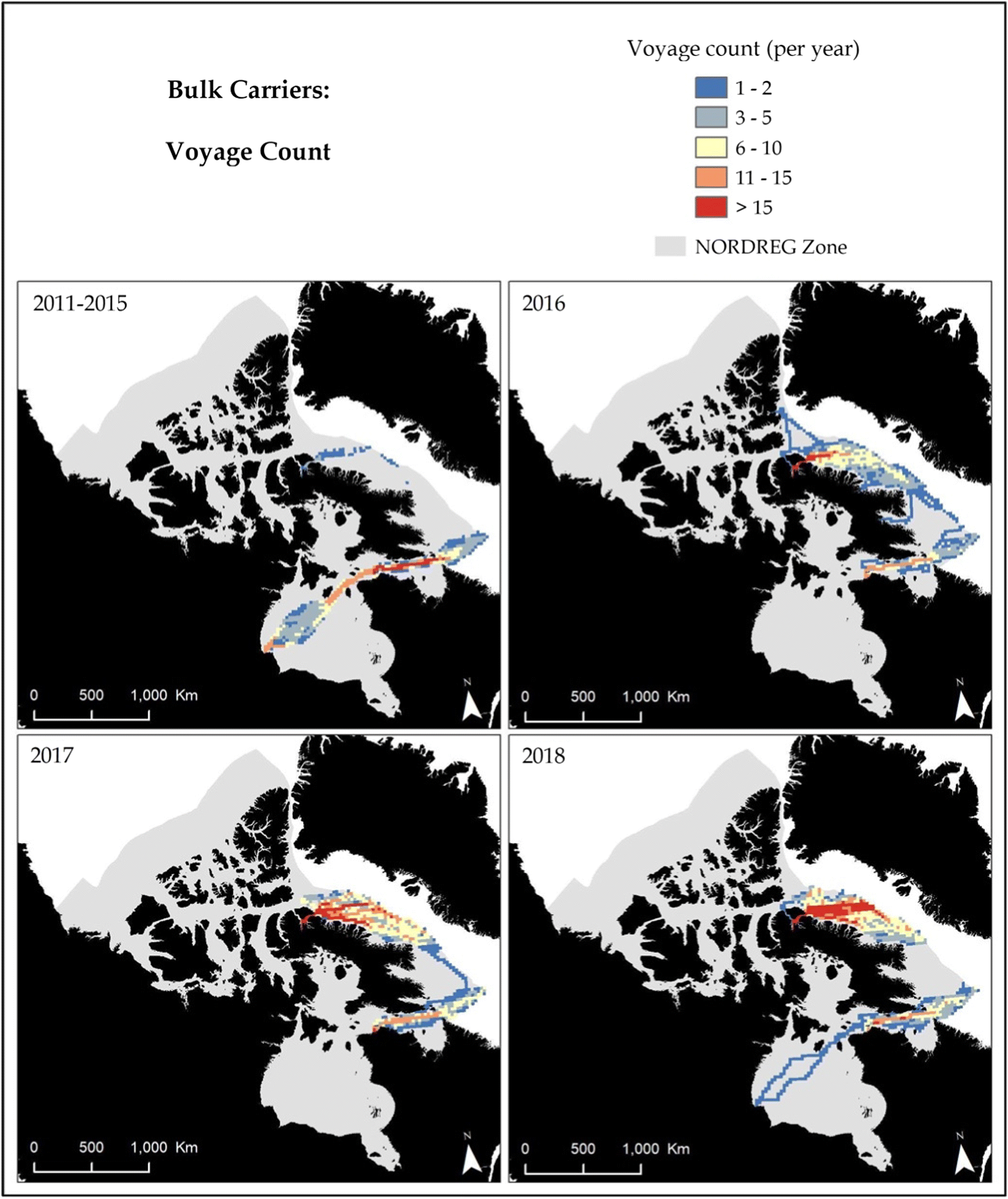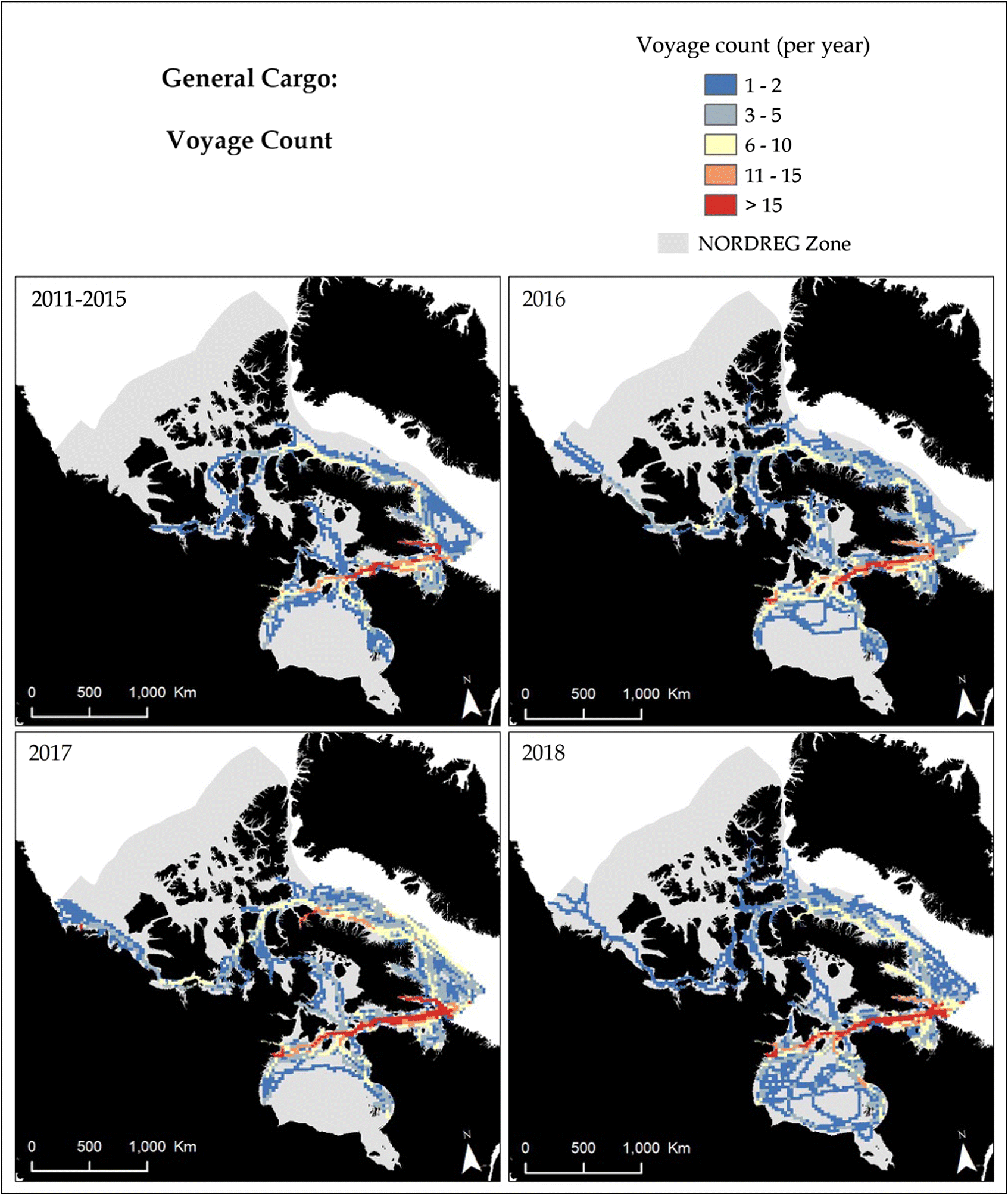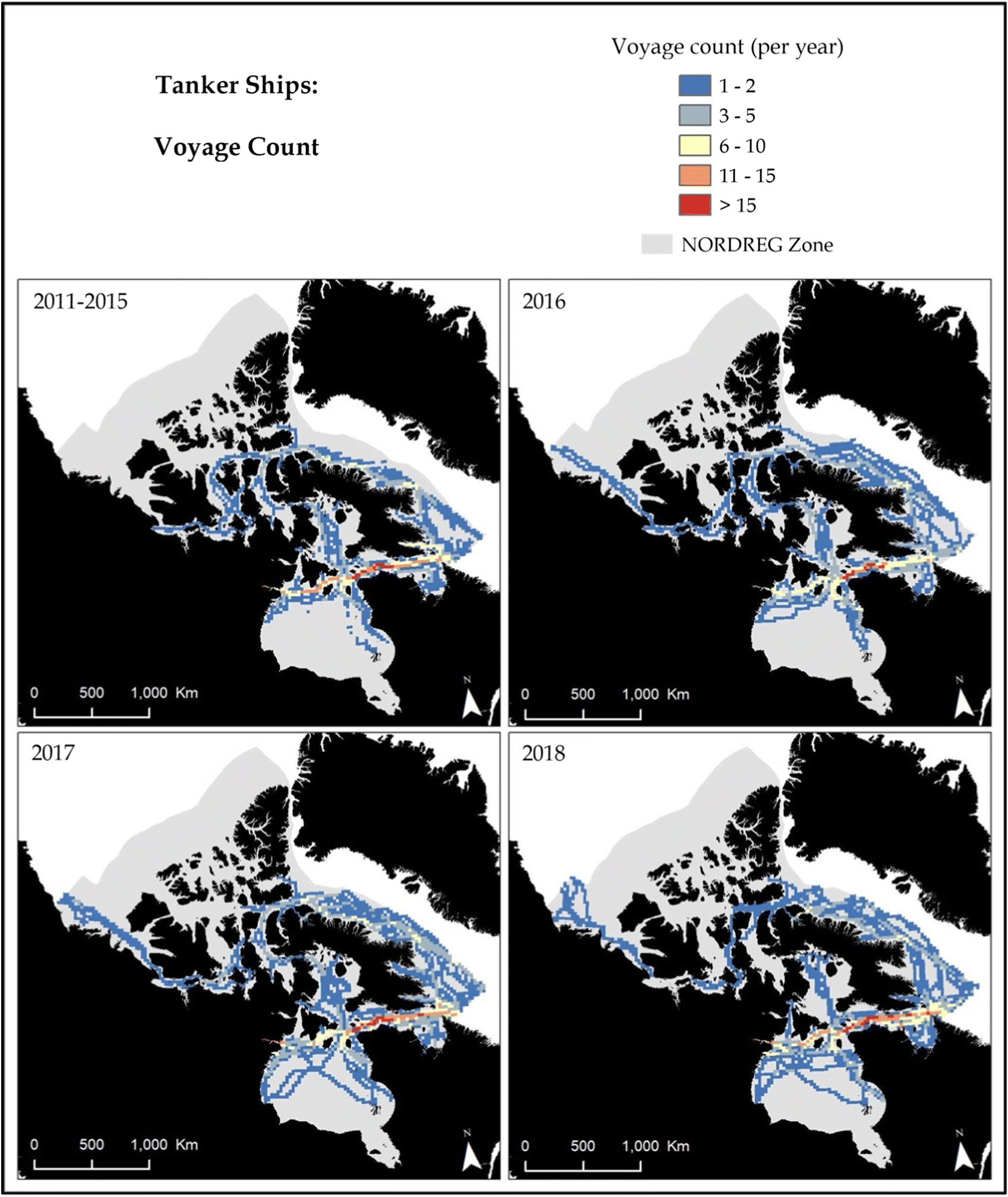Introduction
The International Maritime Organization (IMO), at the 72nd session of the Marine Environment Protection Committee, directed the sixth session of the Pollution Prevention and Response Sub-committee to develop a ban on heavy fuel oil (HFO) use by ships in the Arctic, on the basis of an assessment of the impacts and on an appropriate timescale. It is vital that research on the extent of use and on the impacts of HFO be conducted so that international decision-making can make specific policy decisions and directives that are indeed evidence based. Some research has already been conducted about HFO use in the Arctic (
Det Norske Veritas 2011;
Comer et al. 2016) including a few studies that focused directly on the Canadian Arctic (
Vard 2016;
DeCola and Robertson 2018). The World Wildlife Fund Canada has commissioned and conducted studies that examine the potential impact of HFO use in Canadian Arctic waters and the potential costs of an HFO ban on Canadian Arctic communities that rely on cargo ships for their annual resupply (
Vard 2016;
DeCola and Robertson 2018). In addition, in December 2019, Transport Canada released a report assessing the benefits and impacts associated with a proposed ban on HFO in the Canadian Arctic (
Transport Canada 2019). While it is widely accepted that HFO presents a threat to the marine environment, there is a lack of understanding of the scale and scope of HFO use by ships operating in Arctic waters; therefore, it is difficult to discern the extent to which the proposed ban may affect ship operations in the region. However, there is an overall significant lack of scientific understanding of the specific effects of HFO in Arctic waters and, importantly, there are significant knowledge gaps on the potential implications of an HFO ban for ship operators and local communities in Canada.
In this study, we focus solely on understanding the scale and scope HFO use among ships operating in Canadian Arctic waters and do not comment on the potential implications of the proposed HFO ban. To establish the scale and scope of HFO use among ships operating in Canadian Arctic waters we utilized a variety of research methods to develop a database of fuel use by ships that operated in Canadian Arctic waters between 2010 and 2018. The database was then used to determine the type and size of ships that are most likely using HFO and to determine where (spatially) these ships are travelling within the Canadian Arctic. Before presenting the study methods and results, we provide an overview of HFO use and its potential impacts on the marine environment, briefly touch on policy discussions regarding HFO use in the Arctic and Canadian Arctic specifically, and reflect on the potential impacts a ban could have on Canadian Arctic communities. Further, we consider previous research that has examined HFO in the Arctic to provide the context for our study and methods.
Results
The results of our study show that approximately 37% of all unique vessels travelling through the Canadian Arctic between 2010 and 2018 most likely used HFO.
Tables 2 and
3 break down the findings further by size and by ship type, respectively. The findings show that vessels over 5000 GRT made up the vast majority of HFO use; this finding is similar to
Comer et al. (2016) and
Det Norske Veritas (2011).
Table 3 also shows that bulk carriers, general cargo, and tanker ships made up nearly all of the confirmed and estimated HFO use. This finding was expected and supports previous findings (
Det Norske Veritas 2011;
Comer et al. 2016).
By combining our nonspatial database with our spatial database, we can see a more complete picture of HFO use each year and in which geographic areas of the Canadian Arctic HFO use is more prevalent.
Table 4 shows ship count and distance travelled for all ships (distillate and residual), residual–HFO ships, and residual–HFO ship percentages.
Table 3 shows there were 601 unique vessels travelling through the Canadian Arctic between 2010 and 2018.
Table 4 breaks the ship count down by year, which is shown in
Figs. 3 and
4. We can see that the number of ships using HFO coming through the Canadian Arctic remains relatively stable until 2016, when we start to see a slight increase (
Fig. 3). When examining the total kilometres travelled by ships using HFO, we see that distance travelled has increased slightly since 2010 with a decrease in 2016 (
Fig. 4). Each year the percentage of ships using HFO were relatively consistent until 2018, the same can be said for unique ship count percentage. There are a few points of interest that this analysis demonstrates. Ships using HFO represent 37% of the overall unique ships between 2010 and 2018 (as shown in
Table 3). However, on average, ships using HFO travel further in the Canadian Arctic than ships using distillates. Ships using HFO represent approximately 45% of the total distance travelled between 2010 and 2018 and, in 2018, these ships accounted for over 50% of the total distance travelled among all ships.
Our spatial analysis shows where ships using HFO were travelling between 2011 and 2018 and how this has changed over time.
Figure 5 shows that ships using HFO travel throughout the Canadian Arctic; however, the map clearly shows that there are some areas that experience higher concentrations of ships using HFO, specifically along the Hudson Strait and Eclipse Sound near Pond Inlet, Nunavut, into the Baffin Bay area.
Figure 5 also shows that the number of ships using HFO fuel has increased over time; however, the areas of concentration have remained relatively consistent.
The vast majority of HFO use between 2010 and 2018 in the Canadian Arctic has occurred among three general ship types (there was one tug–barge that was confirmed to be using residual fuel that did not fall into one of these three categories): general cargo, bulk carriers, and tanker ships. General cargo are resupply ships that transport supplies to Arctic communities. Bulk carriers are ships that are designed to carry bulk cargo such as grain, timber, and ore. Pre-2016, the majority of these bulk carrier vessels were used to transport grain from Port of Churchill across the globe, from 2016 onwards they have generally been used to service mines. Tanker ships transport liquids or gases, generally oil or chemicals, and tankers provide fuel and other liquids to communities, mines, and other locations throughout the Canadian Arctic (
Dawson et al. 2018).
Figures 6 and
7 break down residual use into these three categories, which helps to show the changes over time among these three groups, and how and in what context HFO is being used by marine vessels in the Canadian Arctic. On average, between 2010 and 2018 unique general cargo vessels make up 28% of estimated HFO users each year, unique bulk carriers make up approximately 48% of HFO users each year, and tanker ships make up approximately 24% of HFO users each year. In terms of kilometres travelled, on average general cargo vessels travel the furthest distance each year, making up 47% of the kilometres travelled by these three HFO-fueled vessel categories, tanker ships make up 29% of the kilometres travelled per year, and bulk carriers make up 24% of the kilometres travelled per year.
Bulk carriers
The number of unique bulk carrier vessels has remained fairly stable each year from 2010 until we began to see an increase from 2016 (
Fig. 7). When viewing the spatial distribution (
Fig. 8), we can see that between 2011 and 2015 the majority of bulk carriers were travelling to and from the Port of Churchill. These bulk carriers were transporting grain from Canada to global markets. The Port of Churchill, Manitoba, closed in August 2016, which is why so few bulk carriers were seen in this area until the Port of Churchill reopened and its first grain vessel left the Port in September 2019 (
Franz-Warkentin 2019). The figures from 2016 onwards show that despite the Port of Churchill closing, the number of bulk carriers increased.
Figure 8 shows that this increase is directly linked to the increase in bulk carriers travelling to and from Milne Inlet near Pond Inlet, Nunavut, community (most likely caused by traffic related to the Mary River Mine located on Baffin Island), and traffic travelling to and from Deception Bay near Salluit, Quebec (most likely caused by traffic related to Raglan and Nunavik Nickel mines using the port in Deception Bay, Quebec).
Figure 6 also shows that the distance travelled by bulk carriers has also been steadily increasing since 2016. In 2016, bulk carriers surpassed tanker ships for the first time in terms of kilometres travelled. In 2018, the distance travelled by bulk carriers nearly doubled the distance travelled by bulk carriers in 2010.
General cargo
Figures 6 and
7 show that general cargo vessels have fewer unique ships travelling through the Canadian Arctic each year compared with bulk carriers. General cargo vessels overall travel the furthest distance compared with bulk carriers and tanker ships. The number of kilometres travelled by general cargo ships has steadily increased since 2010, whereas the number of unique general cargo vessels coming through each year has remained relatively stable. The spatial figures (
Fig. 9) show that general cargo vessels travel vast distances throughout the Canadian Arctic stopping at different Arctic communities, with the Hudson Strait and northern section of Hudson Bay experiencing the highest intensity of this traffic. Many Arctic communities are only accessible by air or sea and therefore rely on general cargo and tanker ships for their annual resupply. The two main resupply operators in the Canadian Arctic are Desgagnes Transarctik and NEAS (
FedNav 2017). Between 2010 and 2018 the average number of unique general cargo vessels travelling through the Canadian Arctic each year was 14. This is an important point that we will return to in the discussion section.
Figures 9 and
10 also show significant traffic through to Rankin Inlet, Baker Lake, and Chesterfield Inlet, Nunavut, for both cargo and tanker ships, which is likely linked to servicing of the Meadowbank Gold Mine and Meliadine Mine located near Baker Lake and Rankin Inlet, respectively (
Dawson et al. 2018;
Babb et al. 2019), as well as the recently opened Amaruk mine near Baker Lake.
Tanker ships
The number of unique tanker ships and the distance travelled by tanker ships each year has remained relatively stable between 2010 and 2018.
Fig. 10 shows that similar to general cargo vessels, tanker ships travel to many different areas across the Canadian Arctic reflecting their annual resupply routes (
Dawson et al. 2018), with north of Hudson Bay and Hudson Strait again being the points experiencing the highest voyage numbers. Unlike general cargo vessels and bulk carriers, the number of unique tanker ships and distance travelled by tanker ships has not significantly increased between 2010 and 2018 (
Figs. 6 and
7).
Discussion
The study provides a detailed account of HFO use by marine vessels in the Canadian Arctic between 2010 and 2018. The results show that approximately 37% of unique vessels travelling through the Canadian Arctic between 2010 and 2018 were fueled by HFO. In addition, HFO-fueled ships make up approximately 45% of the total distance (kilometres) travelled by all vessels between 2010 and 2018. By 2018, HFO-fueled ships made up nearly 50% of the total distance travelled by all ships in that year. In the Canadian Arctic, we can determine that the vast majority of HFO use is made up of just three different ship categories: bulk carriers, general cargo, and tanker ships. These ship types all operate in different ways and in different areas, which should be considered for potential future HFO ban policies.
The findings show that general cargo travel the furthest distances in relation to other HFO users; however, the number of general cargo vessels is still relatively low. Approximately 14 general cargo vessels travel through the Canadian Arctic each year. This means that switching to distillate fuel could have a relatively higher economic impact on each cargo vessel because of their long-distance travel; however, the cost of making the switch to using distillate fuel, such as modifying engines, could be relatively cheaper overall and have a higher environmental impact because of the low number of vessels relative to the distance travelled. Similar to cargo vessels, tanker ships also have a relatively low number of vessels in relation to the distance travelled. Twelve tanker ships travelled through the Canadian Arctic in 2018. Switching even a small number of general cargo and tanker ships to using distillate fuel could have a large impact on decreasing overall HFO use. Arctic communities rely on general cargo and tanker ships to provide annual sealift (resupply). Resupply shipping companies have confirmed that the increased cost of switching fuel will not be able to be absorbed by the companies and will have to be passed onto communities within the total cost of the goods (
George 2017), which could have profound economic impacts for shipping companies and communities. Both the Canadian Government and Inuit organizations have raised concerns about this issue. Canadian Arctic communities are already experiencing prohibitive food and supply prices, and if costs increased this could contribute to issues around food security (
Wesche and Chan 2010;
Cunsolo Willox et al. 2012). It is imperative that these potential impacts be considered in discussing the proposed HFO ban.
The results show that bulk carriers travel relatively shorter distances in the Canadian Arctic compared with general cargo vessels; however, there are a higher number of them. In 2018, there were 32 unique bulk carriers travelling through the Canadian Arctic. In addition, it is expected that the number of bulk carriers in the Canadian Arctic will continue to rapidly increase as a result of increased mining interests up north. Baffinland, which owns Mary River Mine, and already uses a high number of the bulk carriers in the Canadian Arctic is currently seeking approval for a phase 2 expansion of the mine, which will see them producing double the amount of ore each year (
Frizzell 2019). This will significantly increase vessel counts and distance travelled if it goes ahead. There are also several other proposed mining projects that would rely on marine transport in the Canadian Arctic (
Babb et al. 2019). Currently, the Government of Canada has committed funding for the Grays Bay Road and Port project, which aims to construct a 227 km all-weather road connecting to a deep-sea port at Grays Bay in Coronation Gulf located in the western area of Nunavut (
George 2019b). This road aims to make it more economically viable for mining to occur in these remote areas. The focus of the potential impacts of HFO fuel ban has been on the potential impact that will exist for Canadian Arctic communities. However, our findings show that bulk carriers utilized by mining companies also play a significant role in Canadian Arctic HFO use, and their role is only expected to increase in the years to come. The findings also show that mining companies are contributing to the increase of general cargo and tanker ships in the Canadian Arctic as they use these vessel types to provide supplies and fuel to mines.
In addition, the maps demonstrate that the majority of HFO usage occurs along the Hudson Strait, the north area of Hudson Bay, and Eclipse Sound near Pond Inlet into the Baffin Bay area. This finding is particularly significant as the extensive HFO usage near Pond Inlet occurs in the newly created Tallurutiup Imanga National Marine Conservation Area (NMCA) in Nunavut, which was announced in August 2019. This area has been described as “a large natural and cultural seascape that is one of the most significant ecological areas in the world” (
Parks Canada 2019, para. 1). This area is an important habitat for polar bears, bowhead whale, narwhal, and beluga whale, as well as an important cultural area for local Inuit. Marine conservation areas are created to protect and sustain important ecological environments and HFO-use in this area could pose significant threats to the ecological environment in terms of the negative impacts of air and water pollution and potential oil spills. The Tallurutiup Imanga agreement does not currently include regulations related to shipping (see
IIBA-TINMCA 2019, Article 10, p. 43); however, the agreement does state that the Board (selected to monitor the NMCA) is responsible for the “development of recommendations to responsible authorities, with respect to marine shipping activities within the Tallurutiup Imanga NMCA” (
IIBA-TINMCA 2019, p. 27). This area is used most heavily by the bulk carriers travelling to and from the Mary River mine using Milne Inlet near Pond Inlet to load mined iron ore. Phasing out the use of HFO in mining-related shipping could decrease HFO-use in the Canadian Arctic significantly.
Although the current focus of a potential HFO-ban is for ships to switch to lighter distillate fuels—as this is the easiest and cheapest alternative for most ships—there are other proposed methods of propulsion (see
Det Norske Veritas 2019 for further information on fuel alternatives for marine vessels). LNG is described by
Det Norske Veritas (2019) as a potential alternative; however, there will be costs involved in switching to LNG, including installing LNG machinery and fuel tanks and training of crew. There is also currently a lack of LNG infrastructure in the Arctic, which could present increased difficulties for LNG uptake. In addition, even though when compared with distillate and residual fuels, it has been argued that LNG presents a more environmentally friendly option, the fuel still contributes to greenhouse gas (GHG) emissions, and recently researchers have found that LNG usage in international shipping may produce more GHGs than previously thought (
Pavlenko et al. 2020). In addition, some researchers have also found that very low sulphur fuel oil—recently popularized after the implementation of the 0.5% sulphur cap on fuel in January 2020—may emit higher black carbon emissions than high sulphur fuel oils (
IMO PPR 7/8 2019) Thus, there is a pressing need to seek out other carbon-friendly fuels and (or) innovation into reducing the pollutants emitted by current fuels that could be viable in the years to come. This includes additional investments into oil spill response in the Canadian Arctic to minimize the negative impacts of a spill should one occur. A ban of HFO use and carriage for use in the Arctic is most likely only the beginning of measures to be put in place to limit the environmental impacts of marine vessels in the future.
Det Norske Veritas (2019) explains that “it will no longer be possible to assume a ‘stationary’ regulatory and technology landscape for the lifetime of a ship” (
Det Norske Veritas 2019, p. 49). These are factors that need to be considered in the development of new ships as old ships reach their lifespan and require renewal.
We have compiled data that represent the best estimate of fuel use in the Canadian Arctic thus far; however, it would be valuable to have fuel type usage and carriage data be part of the requirement for reporting by ships that enter Canadian waters. This could provide a more accurate and up to date data set and would provide additional information such as the amount of fuel that ships are carrying in addition to what type of fuel they are using. Availability of this data is invaluable for research and may provide some insight for decision-makers in the creation of fuel use policies and in the continued monitoring of environmental impacts of Arctic shipping. While the discussions around banning HFO use by ships in the Arctic present various challenges—that all deserve consideration—it is important that we continue to work to seek ways to limit our environmental impacts while also considering the importance of economic development and the economic, social, and cultural consequences of all proposed policies.
